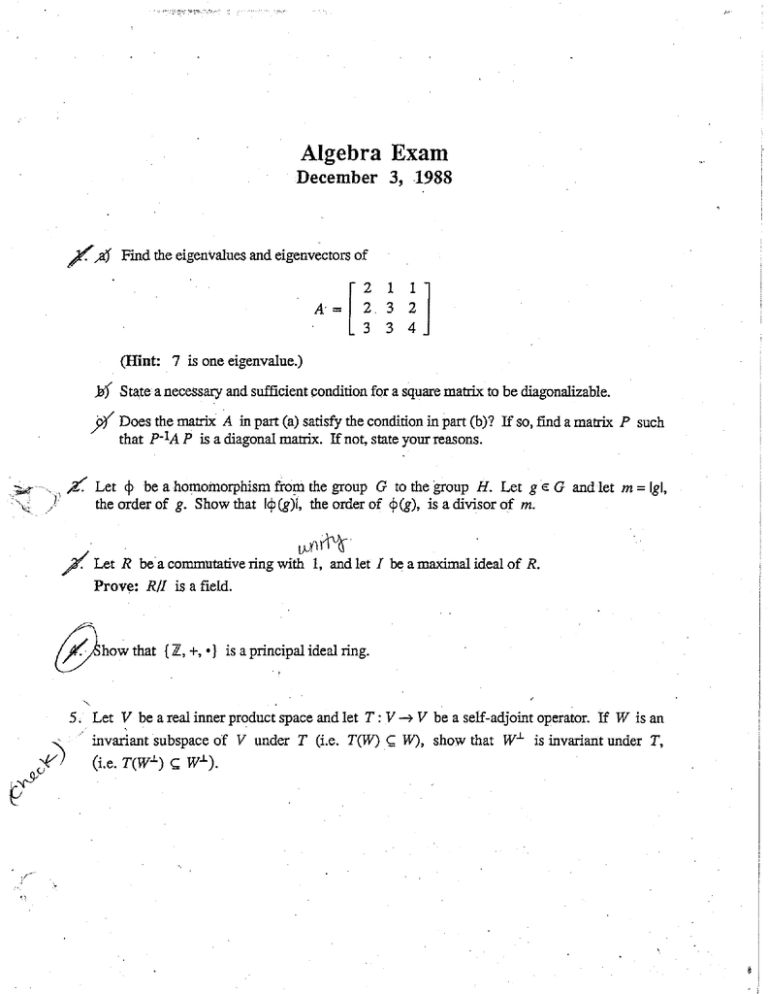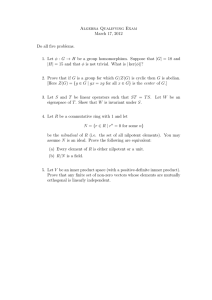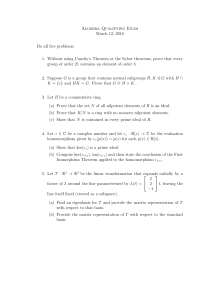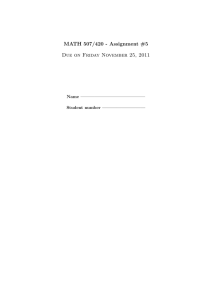Document 11470205
advertisement

Algebra Qualifying Exam
March 15, 2008
Do all five problems.
1. Let G be a group with center Z(G).
(a) Prove: If G/Z(G) is cyclic, then G is abelian.
(b) Prove: If p is prime and G is a nonabelian group of order p3 , then
|Z(G)| = 1 or |Z(G)| = p.
2. Given ideals I, J of a ring R, their ideal quotient is the set
(I : J) = {x ∈ R | xJ ⊆ I}.
Prove that (I : J) is an ideal of R.
3. Let φ : Q −→ Q be a ring automorphism.
(a) Prove that φ(0) = 0 and φ(1) = 1.
(b) Prove that φ(x) = x for all x ∈ Q.
4. Let φ : Z8 ⊕ Z2 ⊕ Z2 −→ Z4 ⊕ Z4 be a group homomorphism.
(a) Show that (4, 0, 0) ∈ ker(φ).
(b) Prove that φ is not surjective.
5. (a) State the Cayley-Hamilton Theorem.
(b) Use the Cayley-Hamilton Theorem to compute A8 , where
1 2
3
0
0 1
2
3
.
A=
0 0 −1
2
0 0
0 −1
Algebra Qualifying Exam
June 7, 2008
Do all five problems.
1. Let G and H be finite cyclic groups. Prove that G ⊕ H is cyclic if and
only if |G| and |H| are relatively prime.
2. Let p be prime. Show that {(px, y) | x, y ∈ Z} is a maximal ideal of
Z ⊕ Z.
3. Let V be a vector space over a field F and let T : V −→ V be a linear
operator. Fix a nonzero vector v ∈ V and define
W = span{v, T (v), T 2 (v), T 3 (v), . . .}.
(a) Prove that W is T -invariant.
(b) If dim(V ) is finite and dim(W ) = k, prove that
B = {v, T (v), . . . , T k−1 (v)}
is a basis for W.
(c) If k = 4, find the matrix of TW with respect to B (where TW
denotes the restriction of T to the subspace W ).
4. List, up to isomorphism, all Abelian groups of order 225.
5. Let R be an integral domain with the property that every strictly
decreasing chain of ideals I1 ⊃ I2 ⊃ I3 ⊃ · · · has finite length. Prove
that R is a field.
Hint: If r ∈ R is nonzero, consider the chain &r' ⊃ &r2 ' ⊃ &r3 ' ⊃ · · ·
Algebra Qualifying Exam
September 16, 2008
Do all five problems.
1. Let G be a group and suppose that G has exactly one subgroup H of
order 50. Prove that H is a normal subgroup of G.
2. Let Rn [x] be the R-vector space of polynomials of degree less than or
equal to n with coefficients in R and let D : Rn [x] −→ Rn [x] be the
derivative operator.
(a) Find the matrix of D with respect to the standard ordered basis
{1, x, x2 , . . . , xn }.
(b) Prove that D is nilpotent (i. e., there exists a positive integer m
such that Dm (p(x)) = 0 for all p(x) ∈ Rn [x]).
3. Prove that a finite integral domain is a field.
4. Let P (R) be the vector space of all polynomials with real coefficients
and let W be the subspace of P (R) defined by
W = {p(x) ∈ P (R) | deg(p(x)) ≤ 1}.
Find the orthogonal projection of the polynomial h(x) = 4 + 3x − 2x2
onto W with respect to the inner product on P (R) given by
Z
hp(x), q(x)i =
1
f (t)g(t) dt.
0
5. Let G be a group and let H, K be normal subgroups of G with H ≤ K.
(a) Prove that K/H G/H.
(b) Prove that (G/H)/(K/H) ∼
= G/K.
Algebra Qualifying Exam
March 20, 2010
Do all five problems.
1. State and prove Lagrange’s Theorem.
2. For an integer n ≥ 2 let Zn denote the group of integers modulo n.
(a) Determine the number of homomorphisms Z12 → Z8 .
(b) Determine the number of epimorphisms Z12 → Z8 .
3. Let R be a commutative ring. Recall that an element x ∈ R is called
nilpotent if for some positive integer n we have xn = 0. Show that the
set N consisting of all nilpotent elements of R is an ideal.
4. Let I be the ideal of R[x] generated by 1 + x2 . Prove that R[x]/I
is isomorphic to C. Note: You may assume without proof that the
division algorithm holds in R[x].
5. Let W be the subspace of R4
3
0
4
0
spanned by
1
1
and
1
0
the vectors
.
Find the matrix P of the orthogonal projection of R4 onto W (with
respect to the usual inner product on R4 ).
Algebra Qualifying Exam
September 15, 2010
Do all five problems.
1. Let G be a group. Suppose H ≤ G and g ∈ G. Show that if the right
coset Hg equals some left coset of H, then in fact Hg = gH.
2. Let G be a group and let NG be the collection
\ of all normal subgroups of
G that have finite index in G. Prove: If
N = {eG }, then, for every
N ∈NG
nontrivial g ∈ G there exists a finite group Kg and a homomorphism
φ : G → Kg such that φ(g) 6= eKg .
3. Let D be an integral domain with identity 1D . Recall that char(D) is
defined to be the smallest positive integer n such that n · 1D = 0, or
zero if no such n exists (here n · 1D denotes 1D + 1D + . . . + 1D ).
{z
}
|
n times
Prove that char(D) is either 0 or a prime.
4. Let R be a commutative ring and suppose I, J are ideals in R. Show
that the set
Q = {r ∈ R | rJ ⊂ I}
is an ideal of R.
5. Let V denote the vector space of 3 × 3 real symmetric matrices and
define the linear transformation T : V → R3 by
1
2
T : A 7→ A ·
0
Find a basis for the kernel of T . [Note: the kernel of a linear transformation is also known as its null space]







